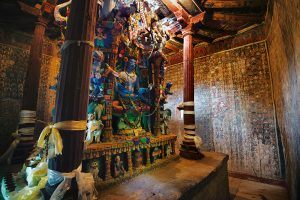David Shulman at the NYRB:
 Peter van Ham’s Alchi, the third volume of a monumental trilogy published by Hirmer on the Buddhist art of western Tibet, must be one of the finest art books ever produced. Its subject, the site of Alchi, sits on the bank of the Indus River in Ladakh, in the high mountain ranges to the east in what is now the Indian state of Kashmir, some thirty-five miles northwest of the capital city of Leh. Unlike Guge, the subject of van Ham’s second volume, Alchi is relatively accessible—good roads now connect Alchi to Leh and (a little less smoothly) to the haunting monastery of Lamayuru, still farther to the north and west.
Peter van Ham’s Alchi, the third volume of a monumental trilogy published by Hirmer on the Buddhist art of western Tibet, must be one of the finest art books ever produced. Its subject, the site of Alchi, sits on the bank of the Indus River in Ladakh, in the high mountain ranges to the east in what is now the Indian state of Kashmir, some thirty-five miles northwest of the capital city of Leh. Unlike Guge, the subject of van Ham’s second volume, Alchi is relatively accessible—good roads now connect Alchi to Leh and (a little less smoothly) to the haunting monastery of Lamayuru, still farther to the north and west.
I visited there with my wife in 2004. A caretaker monk unlocked for us the eleventh-century carved doorway to the Dukhang, every inch of which is painted with Buddhas, Buddhas-to-Be, gods, goddesses, demons, hungry ghosts, imps, flying nymphs, other celestial beings, royal hunters and patrons, monks, Yogi magicians, and many hallucinatory figures that seem to have floated up from the stuff of our dreams. The monk was bored and impatient; after some thirty minutes, he shooed us away. Needless to say, we had no time to unravel even one of the painted tableaux. But I was left, then as now, after spending some weeks with van Ham’s book, with a sense of a dizzying proliferation of vital beings mobbing my eyes. In all of South Asian art, there is nothing quite like these densely painted murals.
more here.
